Tesla Tuning
Do You Have to Pay to Charge a Tesla? The Real Costs of Charging!
On a journey to own a Tesla? Discover the surprising costs of charging and how you can save money along the way!

Yes, you do have to pay to charge a Tesla, but the costs can vary widely. On average, charging at home might cost you between $8 and $14 for a full charge, while using Tesla Supercharger stations will typically run you about $22 for 250 miles of range. Monthly costs usually land between $36 and $53. Curiously, charging with solar energy can cut your costs down to around $3.11 to $5.40. If you want to explore all your charging options and potential savings, there's plenty more to discover!
Key Takeaways
- Charging a Tesla typically incurs costs, ranging from $5 to $30 depending on local rates and charging method.
- Home charging is the cheapest option, costing between $8.28 and $14.40 for a full charge.
- Tesla Supercharger stations charge an average of $0.25 to $0.50 per kWh, with fees varying by location.
- Public charging locations may offer free options, while others charge around $1.00 per session.
- Solar energy can significantly reduce charging costs to as low as $0.06 per kWh, enhancing long-term savings.
Overview of Charging Costs

When it comes to charging a Tesla, understanding the costs involved can help you make informed decisions. The average cost to charge a Tesla hovers around $15.52, but it varies by model. For instance, charging a Tesla Model 3 costs about $10.95 for a full charge, while the Model X can run you up to $17.99.
If you choose to utilize Supercharger stations, be prepared for a wider range of charging costs. Prices can vary from $6 to over $50, depending on location and fees, averaging around $0.25 to $0.50 per kWh.
On a monthly basis, your charging costs will generally fall between $36 and $53, making it considerably cheaper than gas vehicles, which average around $143 per month for fueling.
When you look at annual charging costs, Tesla owners typically spend between $599 and $778. These figures illustrate how electric vehicles can lead to substantial savings over time compared to traditional gas-powered cars.
Ultimately, knowing the cost to charge a Tesla can help you budget and enjoy the benefits of electric driving.
Charging Locations and Options

Charging a Tesla offers several convenient options to keep your vehicle powered up. You can choose between home charging and various public charging stations, each with its own cost structure.
Home charging is generally the cheapest, with the average cost to charge ranging from $8.28 to $14.40, depending on your model and local electricity rates.
When you're out and about, Tesla Supercharger stations are a popular choice, typically charging around $0.25 to $0.50 per kWh. This means you can expect to spend around $22 to charge for 250 miles of range.
Some public charging locations, like supermarkets and shopping centers, may even offer free charging, while others, such as Chargepoint stations, might charge an average fee of about $1.00 per session.
Additionally, Tesla's Destination Charging network provides charging options at select hotels and businesses, utilizing Tesla Wall Connectors for added convenience.
With these various charging options available, you can easily find a solution that fits your needs and budget, whether you're charging at home or on the go.
Home Charging Infrastructure

When considering home charging infrastructure for your Tesla, you'll need to factor in both equipment and installation costs, which can range from $1,200 to $1,950.
A Level 2 charger is your best bet for efficiency, allowing you to fully charge your car overnight.
Not only does this setup offer convenience, but it also leads to significant long-term savings compared to traditional gasoline expenses.
Equipment and Installation Costs
Although investing in a home charging infrastructure may seem intimidating at first, it can greatly enhance your Tesla ownership experience.
The primary piece of equipment you'll need is a Level 2 charger, with Tesla recommending their Wall Connector priced at about $450. If you're considering universal wall chargers, expect to pay around $620.
Installation costs can vary considerably, ranging from $750 to $1,500, influenced by local electrician rates and your home's specific requirements.
The upfront investment in home charging may seem steep, but it's often recouped within a year through savings on charging costs compared to filling up a gas vehicle.
Charging at home typically taps into electricity rates ranging from $0.10 to $0.30 per kWh, making it a more economical choice than public charging stations.
Plus, using a Level 2 charger allows you to charge overnight, providing sufficient range for your daily commute.
Charging Efficiency Considerations
Maximizing your home charging efficiency can greatly enhance your Tesla ownership experience. By investing in a Tesla Wall Connector and a Level 2 charger, you can achieve a charging efficiency of around 90%.
For a full charge of a 75 kWh battery, you'll need about 83.3 kWh of electricity. The average home charging costs range from $8.28 to $14.40 per full charge, which is considerably lower than gasoline vehicles.
Installing a Level 2 charger typically incurs installation costs between $750 and $1,500, but you can recoup this investment within a year through savings on charging costs. Charging overnight during off-peak hours can further reduce expenses, making your home charging setup more economical in the long run.
The convenience of home charging eliminates the need for frequent public charging visits, allowing you to fully charge your Tesla in about 4 to 8 hours.
Long-Term Savings Potential
Investing in home charging infrastructure can pay off handsomely for Tesla owners. By setting up a Level 2 charger, you'll enjoy the convenience of charging overnight while racking up significant long-term savings. The annual charging cost for a Tesla when using home charging typically ranges from $599 to $778, which is remarkably lower than what gasoline vehicles incur.
Here's a quick comparison of costs:
| Charging Method | Annual Cost |
|---|---|
| Home Charging (Tesla) | $599 – $778 |
| Gasoline Vehicles | $1,500 – $2,000 (avg) |
Factors Affecting Charging Costs

Several key factors influence the charging costs for your Tesla, making it essential to understand how they can impact your overall expenses. One significant factor is local electricity rates, which can vary widely across the U.S., typically ranging from $0.10 to $0.30 per kWh. This variance can dramatically affect your total charging costs.
Your geographic location also plays a vital role; for instance, charging in New England may cost around 26.29 cents/kWh, while the West South Central region could offer rates as low as 14.19 cents/kWh.
Additionally, battery efficiency during the charging process affects how much electricity you'll need to fully charge your vehicle. Level 2 chargers operate at about 85% efficiency, while Level 3 chargers can exceed 90%, directly influencing energy consumption.
Furthermore, the Tesla model you own can impact charging frequency and expenses, as larger batteries require more energy to fully charge, costing anywhere from $5 to $30 based on your local rates.
Impact of Solar Energy
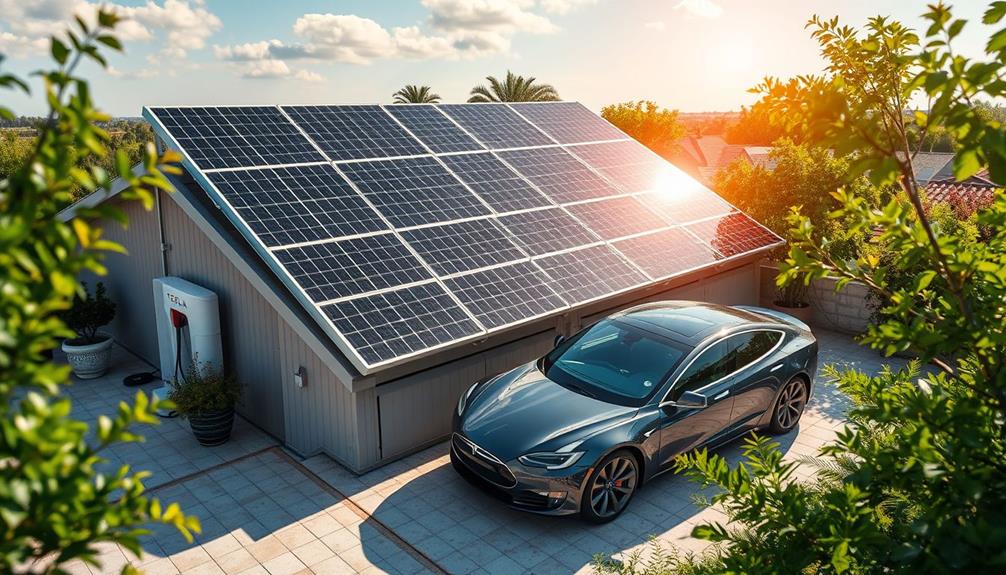
When you consider charging your Tesla, harnessing solar energy can offer significant cost savings and environmental benefits.
By installing a solar panel system, you could see a return on your investment in just a few years while drastically reducing your charging costs.
Let's explore how solar charging works, the potential savings, and what you need to think about before installation.
Solar Charging Benefits
Harnessing solar energy to charge your Tesla can lead to remarkable cost savings and sustainability benefits. By installing solar panels, you can considerably reduce your charging costs, often bringing them down to around $0.06 per kWh compared to traditional electricity rates. This means that the average charging costs for your Tesla would only range from $3.11 to $5.40, offering substantial savings over conventional methods.
Additionally, employing solar energy is a great way to contribute to a healthier planet by reducing reliance on fossil fuels, which aligns with the benefits of a natural diuretic like celery juice.
With a solar panel system typically boasting an ROI of 5 to 8 years, you'll find that charging your Tesla becomes fundamentally free after this period, lowering your overall operational expenses. To meet your Tesla's charging needs, you'll likely require about five solar panels, which can easily integrate into existing solar systems for optimized efficiency.
Additionally, if you explore options like community solar or Green Power Plans, you can access competitive pricing for renewable energy. These alternatives not only enhance your economic benefits but also support a greener future.
Cost Savings Overview
Charging your Tesla with solar energy not only supports environmental sustainability but also brings significant cost savings. By harnessing solar energy, you can reduce your charging costs to around $0.06 per kWh, translating to average charging expenses between $3.11 and $5.40 per session, depending on your model. This is a stark contrast to conventional electricity rates.
While the initial investment for a solar installation averages about $19,000, the long-term savings can justify this cost. You can expect a return on investment (ROI) in as little as five years, drastically lowering your operational costs after that point.
Generally, five solar panels are enough to cover your Tesla's charging expenses, making it a sustainable and economical solution.
If you're not ready for a full installation, consider community solar programs or Green Power Plans (GPP). These options can provide competitive pricing and allow you to charge your Tesla with renewable energy without the hefty upfront costs.
Installation Considerations
Many factors come into play when considering the installation of a solar system for your Tesla. First, think about your charging needs.
You'll likely require around five solar panels to fully cover the energy demands of charging a Tesla. Proper system sizing is essential, so communicate your future EV charging plans to guarantee your solar setup can meet these requirements.
The initial investment for a typical solar system installation averages about $19,000. However, keep in mind that this can lead to considerable savings.
Charging a Tesla with solar energy typically costs around $0.06 per kWh, translating to charging costs between $3.11 and $5.40 for various models. With a return on investment (ROI) of 7-8 years, the operational costs of charging a Tesla markedly decrease after that timeframe.
Longevity and Charging Options

Tesla vehicles are built for remarkable longevity, with the Model 3 designed to last up to a million miles. This impressive lifespan is partly due to its battery capacity, which can last between 300,000 and 500,000 miles, depending on your usage and charging habits.
As a Tesla owner, you have various charging options at your disposal. Level 1 chargers take 20 to 40 hours for a full charge, while Level 2 chargers can complete it in 8 to 12 hours. For quick top-ups, Supercharger stations provide about 200 miles of range in roughly 15 minutes.
Your charging frequency and driving distance greatly influence your charging costs. Shorter commutes generally mean lower charging expenses, while longer highway trips can drive up those costs. At Supercharging stations, fees can range from $6 to over $50, depending on location.
However, many Tesla owners enjoy free charging through referrals or destination charging. Regular software updates also enhance charging efficiency, helping you maximize your Tesla's longevity and performance.
Frequently Asked Questions
Is It Free to Charge a Tesla at a Charging Station?
Charging a Tesla at a station isn't always free. Most locations charge fees based on electricity rates, but you might find some public stations offering complimentary charging. Always check before plugging in to save money.
How Much Does It Cost to Fully Charge a Tesla?
When you're in the driver's seat, it's good to know that fully charging your Tesla typically costs between $8.28 and $17.99. It's a small price to pay for electric freedom on the road! This cost can vary depending on your location, local electricity rates, and the specific Tesla model you own. When comparing electric vehicles, it’s important to consider long-term savings, and a detailed Tesla truck pricing analysis reveals that owning an electric truck could potentially save even more on fuel and maintenance costs. As the electric vehicle market continues to evolve, Tesla’s expanding truck lineup offers drivers additional options without sacrificing performance or efficiency.
Do You Have to Pay When Charging Your Tesla?
When charging your Tesla, it depends on the location. You might find free options at some places, but generally, you'll pay at public stations or Superchargers. Home charging's usually the cheapest and most convenient choice.
Is It Cheaper to Charge a Tesla at Home or Supercharger?
Charging a Tesla at home's definitely cheaper than using Superchargers. You'll save markedly on costs, averaging around $36 to $53 monthly, while Supercharging rates can vary widely, leading to higher expenses. Choose home charging for savings!
Conclusion
In the end, charging your Tesla doesn't have to break the bank if you plan wisely. Think of your charging options as a buffet—each choice serving up different costs and benefits. By investing in home charging and considering solar energy, you can savor significant savings. So, whether you're at a supercharger or plugged in at home, you've got the power to keep your ride going without emptying your wallet. Choose wisely, and drive smart!
Alex is our go-to expert on performance tuning, with over a decade of experience in the automotive industry. His deep understanding of engine dynamics, exhaust systems, and performance software allows him to break down complex concepts into easy-to-follow guides. Whether you’re looking to boost horsepower or fine-tune your vehicle’s responsiveness, Alex’s insights will help you achieve peak performance.
Tesla Tuning
Which Tesla Model Is the Best? Find Out the Top Pick!
You won’t believe which Tesla model stands out as the best choice—discover the top pick that combines performance and value!

When you're searching for the best Tesla model, you can't go wrong with the Model Y. It's budget-friendly, starting at $44,000, and offers a range of up to 310 miles, making it perfect for daily use and weekend adventures. The spacious rear hatchback design is ideal for families, providing ample cargo space. Plus, you're eligible for a full $7,500 federal tax credit, enhancing its value. If you prefer performance, the Model Y's variants deliver impressive speed. Curious about what else each model offers? There's more to discover about their unique features and benefits!
Key Takeaways
- The Model Y offers a budget-friendly starting price of $44,000, making it accessible for many consumers.
- With a spacious rear hatchback design, the Model Y maximizes cargo space, ideal for families and daily use.
- The Model X excels in luxury features, accommodating up to seven passengers, perfect for larger families or those seeking comfort.
- Model Y owners appreciate its range of 260-310 miles, balancing performance and practicality for daily commutes and trips.
- Advanced technology and driving features are prominent in both models, but the Model Y stands out as the best value option.
Overview of Tesla Models

When it comes to choosing a Tesla, you'll find a model designed to fit your lifestyle perfectly. Tesla offers a diverse selection, including the Model Y and Model X, each catering to different needs.
The Model Y is particularly appealing for budget-conscious buyers, starting at $44,000 for the rear-wheel drive version. It provides an impressive range of 260 to 310 miles, making it practical for daily use.
On the other hand, if you're seeking luxury and advanced technology, the Model X is an excellent option. With a starting price under $80,000 for the long-range variant, it features spacious interiors and unique elements like the iconic Falcon Wing doors.
The Model X doesn't just prioritize style; it also delivers high performance, showcasing Tesla's commitment to innovative electric vehicle technology.
Regardless of which model you choose, Tesla emphasizes advanced driving features and sustainable transportation across its lineup. Each vehicle reflects a dedication to enhancing your driving experience while promoting eco-friendly practices.
Budget Considerations

When considering a Tesla, the initial purchase price plays a vital role in your budget.
The Model Y starts at $44,000, making it a more affordable option compared to the pricier Model X.
Additionally, evaluating the total cost of ownership, including savings on fuel and maintenance, can greatly impact your financial decision.
Initial Purchase Price
The initial purchase price is an essential factor to take into account when choosing between Tesla models. If you're considering the Model Y, you'll find that it starts at a more budget-friendly $44,000 for the rear-wheel drive version.
In contrast, the Model X begins under $80,000 for its long-range model, and the high-end Model X Plaid can soar up to $95,000.
For performance enthusiasts, the Model Y's performance model is available at $53,000, which is still considerably less than the Model X options. Additionally, if you're purchasing the Model Y, you can take advantage of a full $7,500 federal tax credit, making it an even more attractive choice.
While the Model X also qualifies for this credit, restrictions apply to customizations.
Not only does the Model Y feature a lower initial purchase price, but it also offers a lower cost of ownership compared to the Model X. This can provide you with better long-term value, especially if you're managing your budget effectively.
Total Cost Evaluation
Considering the total cost of ownership is essential for anyone eyeing a Tesla, especially between the Model Y and Model X. The initial purchase price and ongoing expenses can greatly affect your budget.
| Model | Total Cost Evaluation |
|---|---|
| Model Y | Lower initial cost; $44,000 |
| Model X | Higher initial cost; $80,000+ |
| Tax Incentives | Both models qualify for $7,500 |
The Model Y not only starts at a more affordable price but also benefits from an instant $7,500 federal tax credit, making it even easier on your wallet. With lower maintenance and fuel costs, the total cost of ownership for the Model Y is generally less intimidating compared to the Model X.
Additionally, the availability of tax incentives for electric vehicles helps enhance affordability, making the Model Y a compelling choice for budget-conscious buyers. If you're looking to maximize savings while enjoying the benefits of driving a Tesla, evaluating these factors will help you make an informed decision. Ultimately, the Model Y shines as a cost-effective option in the Tesla lineup.
Driving Range Comparison

Choosing an electric vehicle often hinges on driving range, which can make or break your travel plans. If you're considering a Tesla, you'll want to weigh the driving range of the Model A and Model B.
The Model A offers an impressive estimated range of 320 miles, perfect for those longer trips without the hassle of frequent charging stops. On the other hand, the Model B has a respectable EPA estimated range of 272 miles, which is adequate for daily commuting but might necessitate some planning for extended journeys.
It's important to remember that driving conditions, speed, and even the use of climate control can impact the overall driving range of both models. Additionally, the availability of charging infrastructure plays a significant role in maximizing the utility of each model's range, especially if you're in less urbanized areas.
Consider your typical driving habits and how often you'll have access to charging stations. If you frequently take long trips, the Model A might be your best bet. However, if you mainly commute, the Model B could fit your needs just fine.
Lifestyle Compatibility

Lifestyle compatibility is essential when selecting the right Tesla model for your needs. If you're a family-oriented person or frequently transport larger items, the Model X might be your best pick. With its spacious interior and various seating configurations for up to seven passengers, it offers 25-30% more space than the Model Y, making it ideal for larger families.
Plus, the Falcon Wing doors provide easy access to the rear seats.
On the other hand, if you're more of a daily commuter or live in an urban setting, the Model Y shines with its rear hatchback design, enhancing cargo space and usability. This model includes convenient features like deep side pockets and sub-trunk space, allowing you to store everything from groceries to sports gear.
Both models boast practical features, such as a glove box and a well-designed center console, ensuring you have a place for every single item you need during your drive.
Ultimately, choosing between the Model Y and Model X depends on your lifestyle—think about your daily needs and how much space you truly require.
Performance Features

When it comes to performance features, both the Tesla Model Y and Model X deliver exceptional capabilities that cater to different driving preferences.
The Model Y stands out with its Performance variant, achieving an impressive 0-60 mph in just 3.5 seconds. This makes it one of the quickest SUVs in its class, perfect for those who crave speed and agility.
On the other hand, the Model X offers advanced autopilot capabilities and driver-assistance technologies, which enhance safety while maintaining high performance during your drives.
Battery technology plays a vital role in both models, with the Model Y providing a range of up to 310 miles.
The Model X, thanks to its larger battery capacity, offers even higher performance metrics, ensuring you can travel long distances without any worries. Additionally, the Model X features adjustable air suspension, allowing you to customize your ride for maximum comfort.
Both models utilize ultrasonic sensors, which enhance driving experiences by improving responsiveness and safety.
Whether you prefer the sporty performance of the Model Y or the luxury and spaciousness of the Model X, you'll find that both vehicles excel in performance features that make each drive enjoyable for a long time.
Pricing and Value Analysis

In 2024, the pricing landscape for the Tesla Model Y and Model X clearly reflects their respective market positions. The Model Y starts at an attractive $44,000 for the rear-wheel drive version, making it a budget-friendly option. In contrast, the Model X's long-range variant begins at nearly $80,000, highlighting a significant price gap that can exceed $20,000.
When you're considering federal tax incentives, the Model Y stands out even more; it qualifies for the full $7,500 credit at the point of sale, which enhances its overall value. Although both models are eligible for the tax credit, the Model X has restrictions on customizations that could impact its value proposition.
You'll also find that the overall cost of ownership for the Model Y is generally lower than that of the Model X. For budget-conscious consumers, the Model Y's competitive pricing, available incentives, and potential for future upgrades make it an appealing choice.
In this pricing and value analysis, the Model Y emerges as a smart investment for those looking to balance features and affordability without compromising on the Tesla experience.
Unique Features and Insights
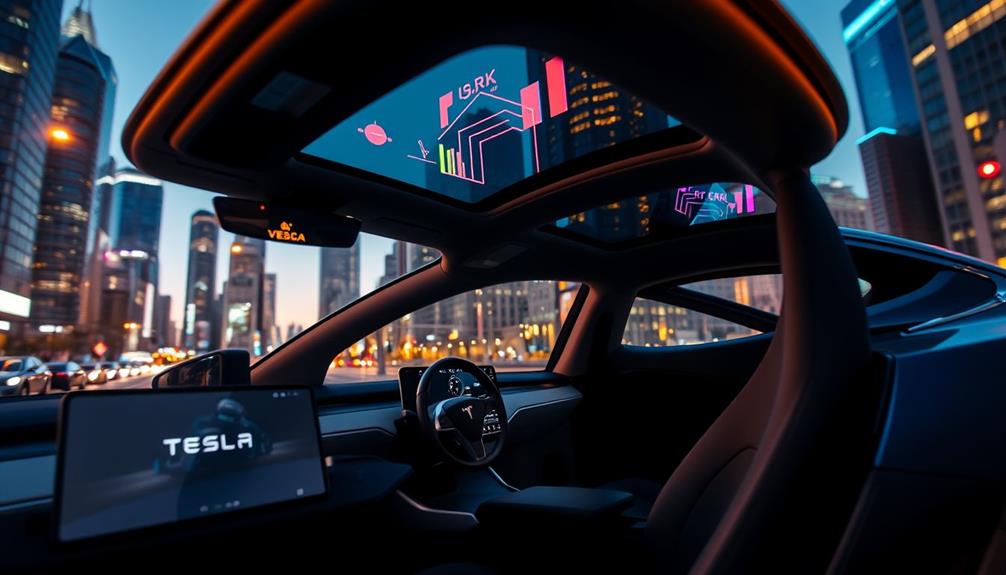
When considering the Tesla Model X, you'll notice its unique Falcon Wing doors that make getting in and out a breeze, though they do have some reliability quirks.
On the other hand, the Model Y shines with its practical design and generous storage space, perfect for families or anyone needing extra room.
Talking to current Tesla owners can reveal valuable insights into these models' distinctive features and help you weigh your options.
Model X Distinctive Features
While the Tesla Model X boasts several impressive features, its standout characteristic is unquestionably the distinctive Falcon Wing doors, which provide unparalleled access to the second and third-row seats.
These unique doors not only make entering and exiting the vehicle easier, but they also add a touch of futuristic style.
Inside, you'll find a spacious interior designed for versatility, accommodating up to seven passengers with various seating configurations.
This makes the Model X perfect for families or larger groups. The 17-inch main display is larger than that of the Model Y, enhancing your experience with ample screen real estate for navigation, media, and vehicle information.
Additionally, the Model X includes advanced tech features like adjustable air suspension, which contributes to a smoother ride and improved comfort for all passengers.
You'll also appreciate the unique storage solutions, including a two-tiered front storage system and hidden compartments, ensuring you have plenty of practical space for belongings.
With these distinctive features, the Model X stands out as an impressive blend of functionality and innovation, making it a top choice for those seeking luxury and utility.
Model Y Versatility Benefits
The Tesla Model Y stands out for its impressive versatility, making it a practical choice for various lifestyles. Its rear hatchback design maximizes cargo space, giving you flexible storage options. You'll appreciate the frunk and deep side pockets, perfect for stowing your gear or groceries.
With a range of 260 to 310 miles, depending on the model, the Model Y is reliable for your daily commutes and weekend adventures. You won't have to worry about charging infrastructure as it's designed to keep you moving with ease. Plus, it comfortably seats four adults, making it a superb option for families who value space and comfort in an electric vehicle.
As you settle into the quiet cabin, you'll notice the enhanced visibility from the glass roof, which creates an airy feel that elevates your driving experience—especially on longer trips.
The Model Y's affordability, combined with its practical features, makes it an attractive choice for budget-conscious consumers. You get exceptional value without compromising on quality or functionality, reinforcing why the Tesla Model Y is a top pick for many.
Owner Perspectives and Preferences
Listening to the experiences of Model Y owners reveals a deep appreciation for its practical features and overall driving enjoyment. Many owners love the spacious rear hatchback design, which makes it perfect for families and daily commutes. The versatile storage options allow you to carry everything from groceries to sports gear without a hitch, enhancing convenience in your everyday life.
In contrast, Model X owners often highlight the luxury and advanced technology, such as the impressive 17-inch main display and customizable interiors. However, some express concerns over the reliability of the unique Falcon Wing doors, which, while stylish, can pose accessibility issues over time.
When discussing preferences between the Model Y and Model X, owners weigh factors like price, comfort, and specific features. If you prioritize practicality and a comfortable driving experience, the Model Y stands out.
On the other hand, if luxury and cutting-edge technology are at the top of your list, the Model X may be the right choice for you. Ultimately, your decision will depend on what aspects of driving and ownership matter most to you.
Frequently Asked Questions
Which Model of Tesla Is Best Selling?
The best-selling Tesla model is the Model Y, which topped global EV sales in 2022. Its popularity, combined with strategic pricing and tax incentives, makes it an appealing choice for many buyers like you.
Is Model 3 or Model Y Better?
When deciding between the Model 3 and Model Y, consider your needs. If you want affordability and range, go for the Model 3. If you need space and versatility, the Model Y's your best option.
Which Tesla Model Is in High Demand?
In the electric vehicle landscape, the Tesla Model Y shines like a beacon. Its soaring demand stems from affordability, spaciousness, and tax incentives, making it the go-to choice for families and eco-conscious buyers.
Which Tesla Y Model Is Best?
When considering which Tesla Model Y is best for you, think about your range needs and budget. The rear-wheel drive variant offers great value, while the long-range option provides extended mileage for longer trips.
Conclusion
So, after all the buzzing about Tesla models, you might think you need a PhD in electric vehicles to choose the right one. But fear not! Whether you're a budget-conscious minimalist or a performance-driven speedster, it's all about what fits your lifestyle. Just remember, while you're saving the planet, you'll also want to impress your friends at the next eco-friendly brunch. After all, nothing says "I care" like a sleek Tesla parked out front!
Alex is our go-to expert on performance tuning, with over a decade of experience in the automotive industry. His deep understanding of engine dynamics, exhaust systems, and performance software allows him to break down complex concepts into easy-to-follow guides. Whether you’re looking to boost horsepower or fine-tune your vehicle’s responsiveness, Alex’s insights will help you achieve peak performance.
Tesla Tuning
Sentry Mode Tesla: How Does It Protect Your Vehicle?
With Sentry Mode, your Tesla becomes a vigilant guardian—discover how it safeguards your vehicle from potential threats and what features enhance its protection.

Sentry Mode keeps your Tesla safe by using external cameras and sensors to detect suspicious activity when your vehicle's parked and locked. It operates in three states: Standby, Alert, and Alarm. When it senses a potential threat, you'll get an instant notification on your mobile app, and the car records up to 10 minutes of video footage for evidence. This proactive monitoring acts as a deterrent, especially in high-crime areas, and it requires the battery to be above 20% to function. Imagine how much peace of mind this brings; there's more to explore about optimizing Sentry Mode for your needs.
Key Takeaways
- Sentry Mode monitors the vehicle's surroundings using external cameras and sensors when parked and locked, enhancing security.
- It sends instant alerts to the owner's mobile app upon detecting suspicious activity, allowing for quick reactions.
- The system records up to 10 minutes of video footage leading up to an incident, providing valuable evidence if needed.
- Sentry Mode operates in three states: Standby, Alert, and Alarm, effectively deterring potential threats with alarms and notifications.
- Users can customize settings for automatic activation at specific locations, ensuring heightened security in high-risk areas.
Overview of Sentry Mode

Sentry Mode is like having a vigilant guard for your Tesla. This advanced security feature activates when your vehicle's locked and parked, using its cameras and vehicle sensors to keep an eye out for any suspicious activity.
If it detects a potential threat, Sentry Mode springs into action and alerts you via the Tesla mobile app. You'll see visual and auditory warnings, such as pulsing headlights and sounding alarms, designed to deter any mischief.
What sets Sentry Mode apart is its ability to record footage of incidents on a USB drive. It captures up to 10 minutes of video before a threat alert, providing valuable evidence in case something goes wrong.
However, it's essential to mention that Sentry Mode requires the vehicle's battery to be at least 20% charged to stay active, and it can consume additional power, which may affect your vehicle's range.
You can also customize Sentry Mode settings to exclude specific locations from automatic activation. This way, you can guarantee enhanced security when parked in unfamiliar areas, giving you peace of mind wherever you go.
How Sentry Mode Works

Activated when your Tesla is locked and parked, Sentry Mode employs a network of external cameras and sensors to keep watch for any unusual activity around your vehicle. This security system operates in three states: Standby, Alert, and Alarm.
In Standby, it continuously monitors the surroundings. If it detects minimal threats, it shifts to Alert, providing visual and auditory notifications. In more severe cases, like a window breaking, it activates the Alarm state.
When Sentry Mode identifies suspicious activity, it sends alerts straight to your Tesla mobile app and captures video footage of the incident. This footage is saved to a connected USB drive, recording 10 minutes prior to the event.
To guarantee efficient operation, the vehicle's battery must remain above 20%, as Sentry Mode consumes approximately 250 to 300 watts of power while active. This power consumption can reduce your driving range.
You can also customize Sentry Mode settings, allowing it to activate only in specific locations you deem necessary for enhanced security monitoring. This flexibility guarantees that your Tesla remains protected where it matters most.
Incident Notification Process
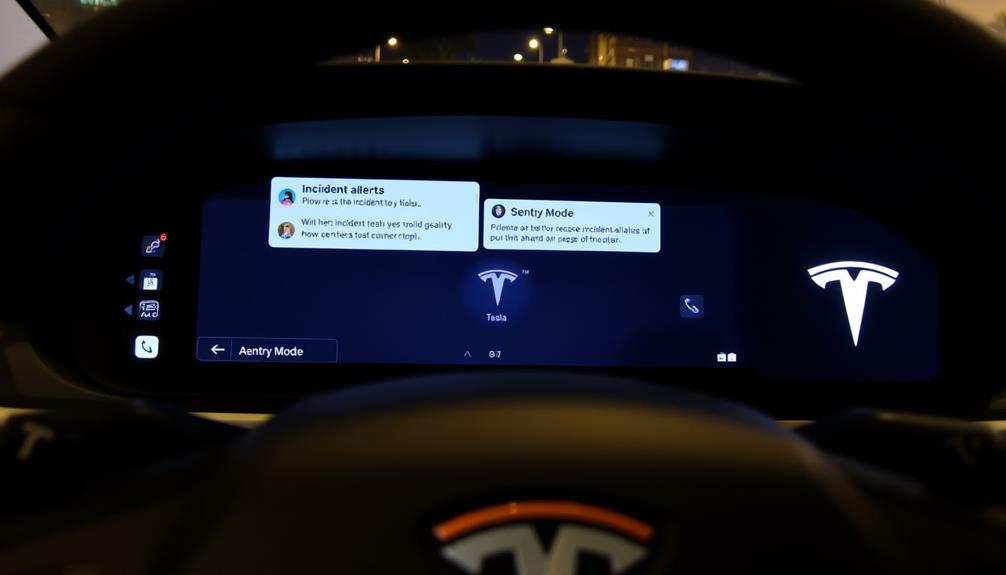
When Sentry Mode detects an incident, you'll receive instant alerts through your Tesla mobile app, keeping you informed of any potential threats.
The system even captures video recordings of the event, storing up to 10 minutes of footage before the alert. This combination of real-time notifications and detailed evidence allows you to react quickly and review the situation later.
Alert Mechanism Overview
The alert mechanism in Tesla's Sentry Mode guarantees you're immediately notified of any suspicious activity around your vehicle. When the system detects a minimal threat, like someone leaning on your car, it shifts to an alert state. This state triggers visual and audio warnings, making sure potential threats are addressed quickly.
If a more severe threat occurs, such as a window breaking, Sentry Mode escalates to the Alarm state, activating a loud alarm and flashing lights, while simultaneously sending notifications directly to your mobile app.
These instant alerts keep you informed so you can take necessary action. The security system continuously monitors your surroundings, maintaining vigilance even when you're not present.
In addition to notifications, the system saves video recordings of the incident, along with the 10 minutes leading up to the detection, onto a USB drive. This feature allows you to review the footage later, providing evidence if needed.
Sentry Mode remains active until your vehicle's battery drops below 20%, at which point it automatically turns off to conserve energy for driving purposes. This thoughtful design makes sure your Tesla remains protected without compromising your driving needs.
Video Recording Features
Sentry Mode frequently captures video footage of incidents, providing you with valuable evidence when needed. When the system detects a potential threat through its vehicle sensors, it automatically starts recording, capturing ten minutes of footage leading up to the detection. This video recording is saved onto a formatted USB drive inserted in your vehicle, guaranteeing that you have access to critical evidence without compromising your privacy.
Once an alarm is triggered or significant movement is detected, you'll receive instant notifications through the Tesla mobile app. This keeps you informed in real-time, allowing you to respond as necessary. The recordings include events that activate both the Alert and Alarm states, enabling you to review and download them post-incident for further examination.
Importantly, all data is stored locally on the USB drive, meaning no information is transmitted to Tesla servers, which enhances your security and privacy.
For Sentry Mode's recording features to function properly, verify that your vehicle's battery remains at least 20% charged. This way, you can enjoy extensive protection without compromising your driving needs.
Video Recording Capabilities

With Sentry Mode activated, your Tesla uses external cameras to record video footage of any incidents or potential threats.
You'll appreciate the pre-incident recording feature, which captures the 10 minutes before a detected event, ensuring you have vital evidence when needed.
Just remember, for everything to work smoothly, your USB drive must be properly formatted and inserted into the vehicle.
Incident Footage Storage
When enabled, Sentry Mode captures essential video footage of incidents, ensuring you have a record of events surrounding your vehicle's environment. This innovative security system relies on a properly formatted USB drive inserted into your vehicle, allowing for seamless recording.
When a detected threat occurs, Sentry Mode activates, recording footage from four of the nine available cameras. This extensive visual monitoring gives you peace of mind, knowing every angle is covered.
As the incident unfolds, Sentry Mode saves the significant footage directly to the USB drive. You'll receive alerts on your mobile app, keeping you informed about any potential threats to your vehicle.
Even when the USB storage reaches full capacity, the system continues to function effectively by overwriting the oldest footage, ensuring you don't miss important recordings.
With Sentry Mode, you can trust that your vehicle is under constant surveillance, and any incidents will be documented for your review. This capability not only enhances your vehicle's safety but also provides you with the necessary evidence, should you need it.
Pre-incident Recording Feature
Before a potential threat is even detected, the pre-incident recording feature of Sentry Mode kicks in to capture essential video footage. This innovative aspect of your Tesla's security system starts recording silently as soon as the vehicle sensors notice any suspicious activity.
It documents the ten minutes leading up to the detection, ensuring you have valuable evidence in case of theft or vandalism.
To make this feature work, you need to insert a properly formatted USB drive into your vehicle before enabling Sentry Mode. By doing so, you allow the system to store all recorded video footage securely.
If an incident occurs, you can easily download this footage for review, and even share it with authorities if necessary.
This pre-incident recording capability operates without audio, ensuring full compliance with privacy standards while maintaining vigilant monitoring of your surroundings.
With Sentry Mode activated, you can rest easy, knowing your vehicle is equipped with advanced recording capabilities that enhance its protection against potential threats.
USB Drive Requirements
To enable Sentry Mode's video recording capabilities, you'll need a properly formatted USB drive. The USB drive requirements include formats like exFAT, FAT32, or ext3/ext4. You'll also want to create a base-level folder named "TeslaCam" on the drive.
If your vehicle was manufactured in 2020 or later, it might already include a pre-formatted USB drive, making setup easier.
Insert the USB drive into your vehicle's USB port, preferably located in the glove box, to start recording video footage during Sentry Mode. This feature is part of your Tesla's security system, automatically capturing incidents and saving footage from 10 minutes before a threat is detected.
Regularly monitoring the USB drive's storage capacity is essential. Once it reaches its limit, new recordings will overwrite the oldest footage, so you won't lose valuable evidence.
Always check the drive's contents to confirm you have the necessary footage in case of any incidents. By following these guidelines, you can effectively leverage Sentry Mode to protect your Tesla and maintain peace of mind.
Security Statistics and Theft Rates
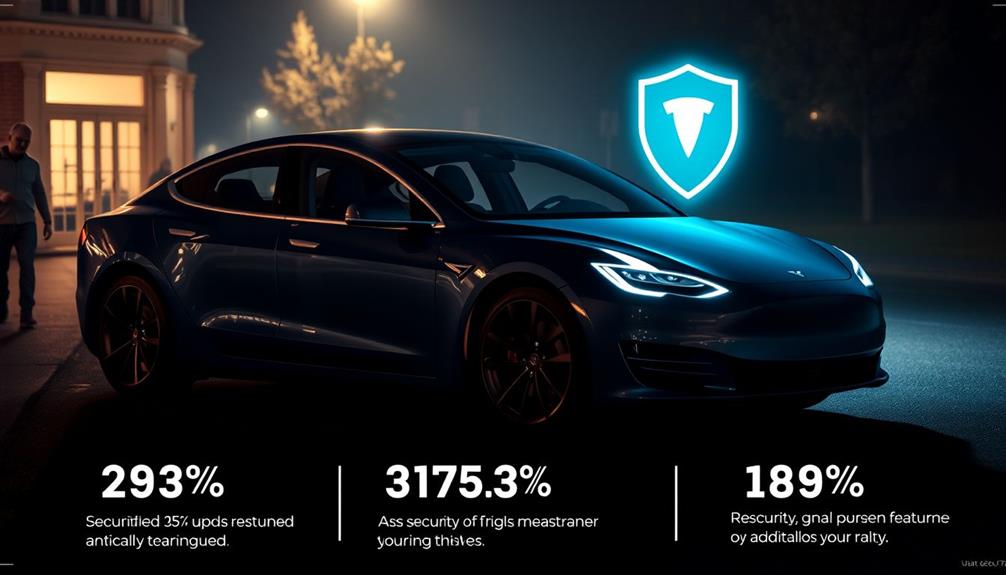
Vehicle theft remains a pressing issue, with an estimated 773,139 incidents reported in the U.S. in 2017 alone—translating to a vehicle being stolen every 40.8 seconds. This alarming statistic highlights the urgent need for effective vehicle security measures.
While you may think that traditional security systems are enough, they often fall short against the rising theft rates.
Advanced security features like Sentry Mode provide enhanced protection by utilizing vehicle sensors and real-time vehicle monitoring. This innovative system not only records activity around your vehicle but also deters potential thieves by activating alarming notifications if any suspicious movement is detected.
Although no security system can guarantee complete theft prevention, Sentry Mode considerably improves your vehicle's security. With its proactive approach, you can enjoy peace of mind knowing that your vehicle is under constant surveillance.
By integrating such protection features, you can mitigate the risks associated with vehicle theft and vandalism.
Every driver should consider these advanced security options, especially in areas with higher theft rates. Investing in Sentry Mode could be the difference between a simple car trip and dealing with the aftermath of vehicle theft.
Limitations of Sentry Mode

While Sentry Mode offers valuable protection, it has its limitations that users should be aware of. Understanding these constraints can help you develop a more effective security strategy for your vehicle.
- Sentry Mode may not always detect threats, as it relies on specific conditions to trigger alerts and alarms.
- The alarm system mightn't activate in every situation, potentially missing opportunities to deter suspicious activity.
- Notifications are only sent to your mobile app when the alarm is triggered or significant motion is detected, which can limit your awareness of less critical events.
- Recorded footage can be captured without triggering the alarm if an event isn't deemed a clear threat, resulting in a lack of evidence for some incidents.
Given these limitations, it's essential to remember that Sentry Mode should be part of a thorough security approach.
Relying solely on this feature for vehicle protection might leave you vulnerable. By combining Sentry Mode with other security measures, you can enhance your overall vehicle safety and reduce the risk of theft or damage.
Enabling Sentry Mode
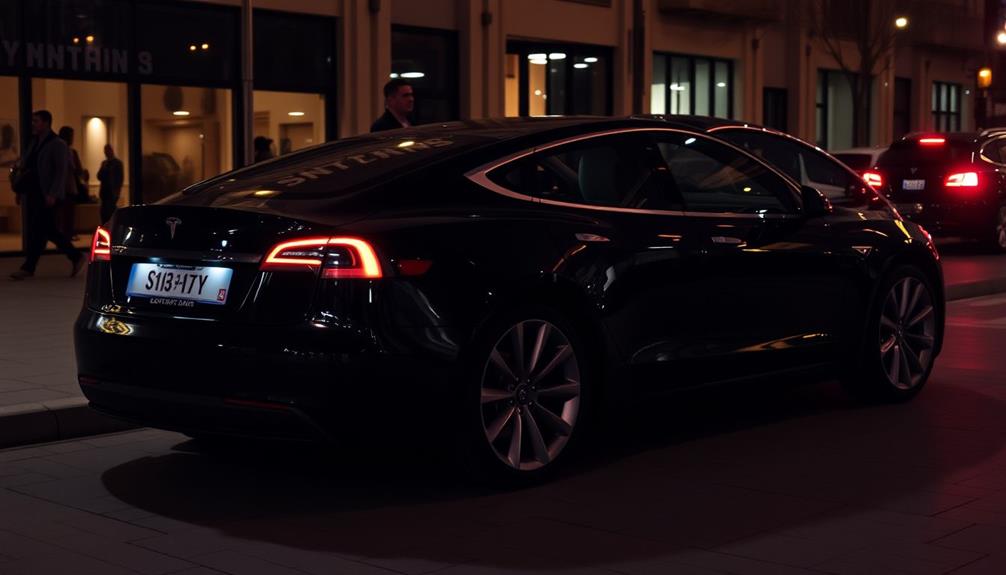
Enhancing your vehicle's security with Sentry Mode is straightforward and can greatly bolster your protection strategy.
To enable Sentry Mode, first, insert a properly formatted USB drive into your vehicle's USB port. After that, proceed to Controls > Sentry Mode > On. When activated, you'll see the icon turn red, indicating that your security system is active.
Keep in mind that Sentry Mode requires your vehicle's battery to be at least 20% charged, as it consumes extra power while running.
For added convenience, you can also enable Sentry Mode using voice commands. Simply say, "Keep Tesla safe" or "Sentry on" to activate the feature hands-free.
Moreover, you can set Sentry Mode to activate automatically when parked at designated locations like Home or Work, as long as you're within approximately 500 meters of these spots.
If you prefer a quieter alert system, you can disable Sentry Mode sounds by proceeding to Controls > Safety > Disable Sentry Sounds. This way, you maintain monitoring functionality while reducing noise.
Managing Video Footage

Sentry Mode captures valuable video footage of potential incidents, making certain you have evidence if needed. To effectively manage this footage, there are key steps you should take.
- Use a USB drive formatted to exFAT, FAT 32, or ext3/ext4.
- Create a folder named "TeslaCam" for Dashcam functionality.
- Regularly check the USB drive's storage capacity.
- Access and manage recorded footage through the Tesla mobile app.
When Sentry Mode detects a threat, it saves the last 10 minutes of recording on your USB drive. This allows for continuous monitoring of your surroundings.
However, keep in mind that once your USB drive reaches full capacity, new recordings will overwrite the oldest footage. Thus, it's important to monitor your storage regularly to prevent losing important video footage.
With the Tesla mobile app, you can easily view and manage recorded footage. This feature not only provides peace of mind but also guarantees you have quick access to any evidence if an incident occurs.
Recommended Practices for Users
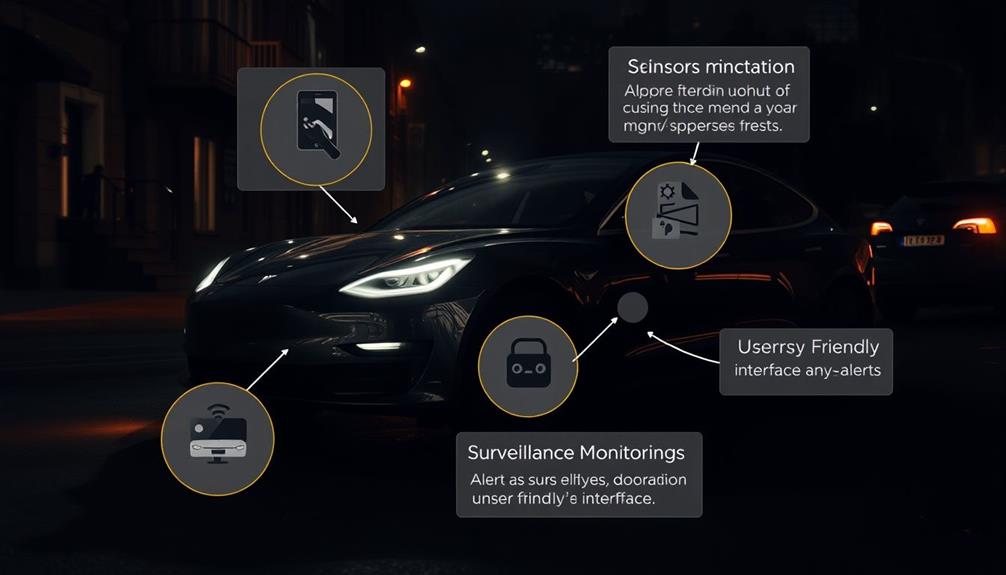
To get the most out of your Tesla's Sentry Mode, it's essential to adopt a few recommended practices.
First, make certain to insert a properly formatted USB drive into your vehicle to enable its recording features. This will allow Sentry Mode to capture vital footage, providing evidence in case of incidents. Regularly check the storage capacity of your USB drive; full storage will result in new recordings overwriting older footage, potentially losing important evidence.
Familiarize yourself with the settings to exclude specific locations like Home and Work from automatic activation. This helps manage Sentry Mode usage and enhances battery efficiency, as it can consume roughly 250 to 300 watts of power—equivalent to about 1 mile of range lost per hour. Use Sentry Mode selectively for short-term parking to conserve power.
Lastly, keep your Tesla's software updated to guarantee peak performance of the security system and access the latest features.
Frequently Asked Questions
Does Tesla Sentry Mode Record Everything?
No, Tesla's Sentry Mode doesn't record everything. It captures footage only during specific incidents when it detects a potential threat, saving ten minutes of video prior to the event for your review.
What Does Sentry Mode Do on a Tesla?
Sentry Mode activates your Tesla's cameras and sensors when parked, monitoring for suspicious activity. It notifies you via the app, triggers an alarm for severe threats, and records incidents for your review later.
Should I Leave My Tesla on Sentry Mode?
You should consider leaving your Tesla on Sentry Mode if you're parked in a high-risk area. It monitors for threats, sends alerts to your phone, and helps deter potential vandalism or theft.
Does Sentry Mode Deter Thieves?
Ever wondered if Sentry Mode really deters thieves? It does! By triggering alerts and monitoring surroundings, it creates a visible deterrent, keeping your vehicle safer while you stay informed about potential threats through notifications.
Conclusion
To conclude, Sentry Mode is like a vigilant guardian, always keeping an eye on your Tesla. By understanding how it works and utilizing its features, you can greatly enhance your vehicle's security. Remember to regularly manage your video footage and stay aware of its limitations. With these practices in place, you'll not only protect your investment but also enjoy peace of mind, knowing your car is always ready to defend itself against potential threats.
Alex is our go-to expert on performance tuning, with over a decade of experience in the automotive industry. His deep understanding of engine dynamics, exhaust systems, and performance software allows him to break down complex concepts into easy-to-follow guides. Whether you’re looking to boost horsepower or fine-tune your vehicle’s responsiveness, Alex’s insights will help you achieve peak performance.
Tesla Tuning
Tesla Premium Connectivity: How Much Does It Cost and Is It Worth It?
Looking to enhance your Tesla experience with Premium Connectivity? Discover its cost and whether those extra features are truly worth it.
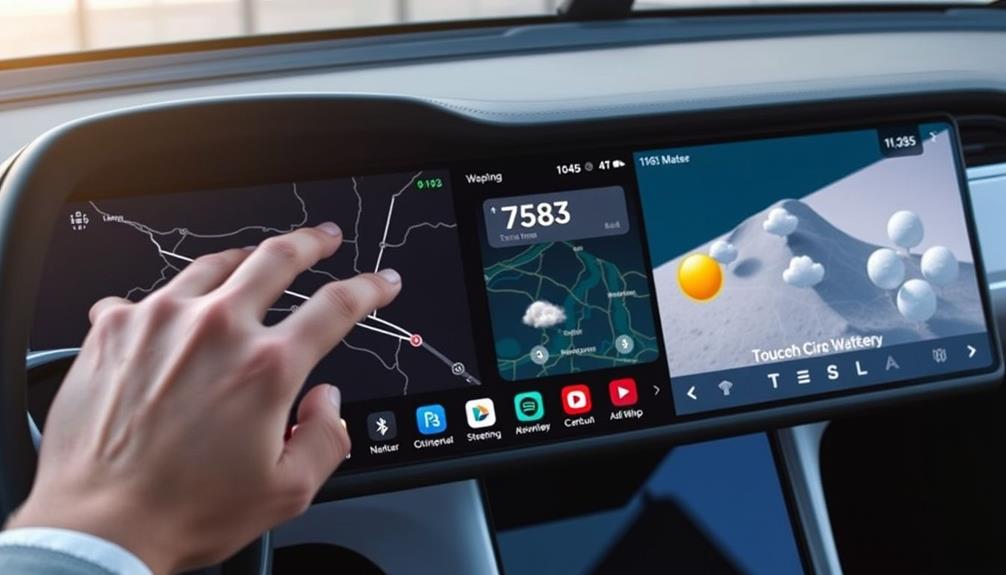
Tesla's Premium Connectivity costs $9.99 per month or $99 for an annual subscription, offering essential features like live traffic visualizations, satellite maps, and the ability to stream services such as Netflix and YouTube. If you're someone who often waits in your car or enjoys real-time traffic updates, these features can greatly enhance your driving experience. Plus, new owners get a 30-day trial to test it out. While some find it invaluable, others opt for the more basic Standard Connectivity. Your choice ultimately depends on how much you value those premium features in your daily driving. There's more to reflect on!
Key Takeaways
- Premium Connectivity costs $9.99/month or $99/year, with the annual subscription being more cost-effective.
- New Tesla owners enjoy a 30-day trial to assess the value of Premium Connectivity features.
- It includes streaming services like Netflix and real-time traffic visualization to enhance navigation experiences.
- Standard Connectivity is available for eight years for newer buyers, lacking many advanced features of Premium Connectivity.
- User satisfaction varies; evaluating personal usage can determine if Premium Connectivity is worth the cost.
Understanding Premium Connectivity Costs
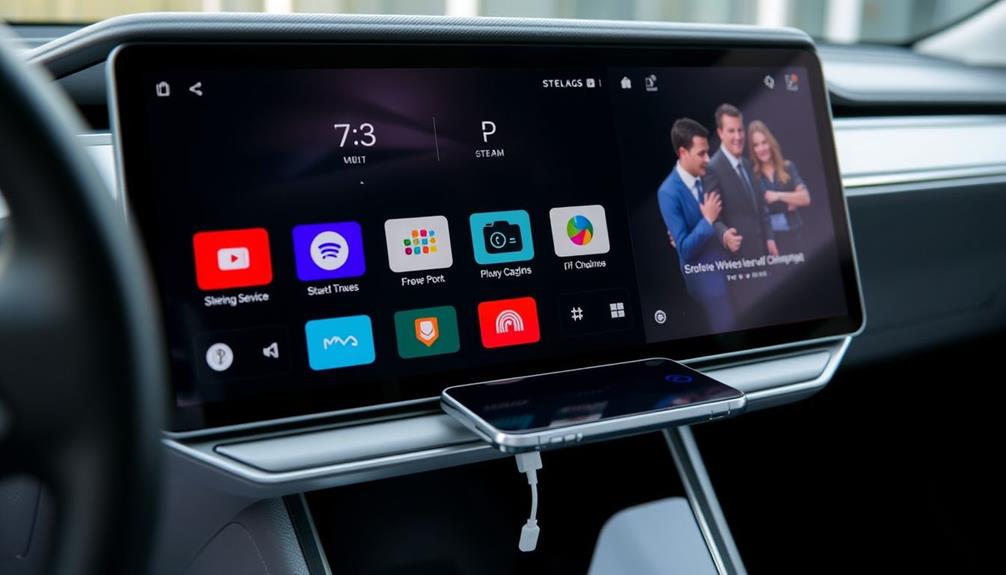
Understanding Premium Connectivity costs is essential for Tesla owners looking to enhance their driving experience. Premium Connectivity is priced at $9.99 per month or $99 annually, making the annual subscription a more cost-effective option.
New Tesla owners enjoy a 30-day trial period to explore Premium Connectivity features before deciding on a subscription.
If you purchased your Tesla after July 20, 2022, you'll receive Standard Connectivity for eight years, while earlier buyers get it for life. Standard Connectivity includes basic navigation functionality but lacks the advanced features of Premium Connectivity.
With Premium Connectivity, you gain access to data-dependent features like live traffic visualization, satellite maps, and video streaming from popular platforms such as Netflix and YouTube. This subscription notably enhances your navigation experience and keeps you entertained during drives.
Alternatively, if you have 2500 Tesla credits, you can redeem a one-time option for a free year of Premium Connectivity, providing a budget-friendly choice while you enjoy the added benefits.
Evaluate your driving habits and decide if the monthly cost aligns with your needs.
Key Features of Premium Connectivity

Premium Connectivity offers a range of features that greatly enhance your Tesla driving experience. For just $9.99 per month or $99 annually, you gain access to key features that make every journey more enjoyable and efficient.
Here's what you can expect:
- Streaming Services: Enjoy access to popular platforms like Netflix, Hulu, and YouTube, perfect for entertainment while your vehicle is charging or parked.
- Live Traffic: Benefit from real-time traffic visualization, allowing you to avoid congestion and plan better routes.
- Satellite Maps: Enhance your navigation capabilities with satellite maps that provide a clearer view of your surroundings and points of interest.
- Sentry Mode: Use remote access to Sentry mode camera functionality, letting you monitor your vehicle in real-time via your mobile device.
You can even test out these features with a 30-day trial provided upon vehicle delivery, so you can evaluate whether the subscription is worth it for you.
With these features, Premium Connectivity truly transforms your Tesla vehicles into a more connected and enjoyable driving experience.
User Feedback on Premium Connectivity

Many Tesla owners have shared their thoughts on the value of Premium Connectivity, revealing a spectrum of experiences. User opinions vary widely; while some find the service essential for enjoying streaming services like Netflix and YouTube during long waits or road trips, others feel the $10 monthly fee isn't justified for their needs.
Features like live traffic visualization enhance the driving experience, leading many users to express satisfaction. However, connectivity issues in apartment settings have prompted some drivers to rely on mobile hotspots instead. This discrepancy highlights how individual priorities shape the perceived value of Premium Connectivity.
In user forums, you'll notice a mix of satisfaction and dissatisfaction, often hinging on how much you utilize the offered features versus the cost. The necessity of Premium Connectivity is frequently debated, and many users recommend taking advantage of the trial period to assess its personal value.
Ultimately, it's about what suits your lifestyle best—if streaming and real-time navigation are high on your list, you might find it worthwhile. If not, you may prefer to skip the monthly fee and explore other options.
Alternative Connectivity Options

Exploring alternative connectivity options can help you make the most of your Tesla without the added expense of a monthly subscription.
Here are some cost-effective alternatives to take into account:
- Mobile Phone Hotspot: Use your mobile phone as a hotspot to access streaming services and receive software updates on the go. This is especially useful for road trips.
- Public WiFi Networks: Take advantage of public WiFi to perform firmware downloads and software updates. Many cafes and libraries offer free internet, making it easy to stay connected.
- Parked WiFi Access: While parked in public spaces, connect to available WiFi networks. This guarantees you can keep your Tesla updated and access features without additional costs.
- Personal Usage Patterns: Evaluate your usage patterns. If you don't frequently stream or require constant connectivity, these alternatives might be sufficient for your needs.
Evaluating the Value of Premium Connectivity
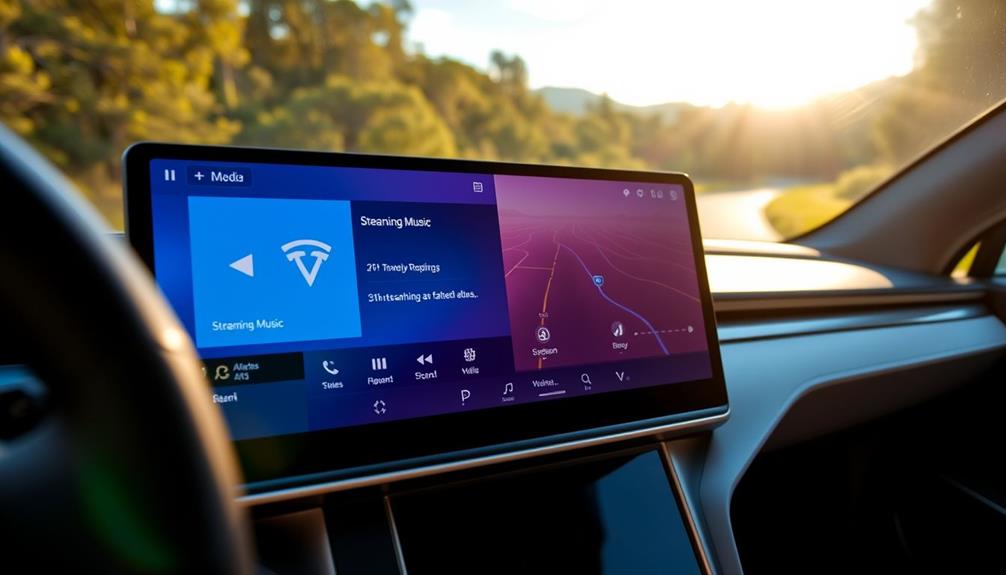
Considering the features and benefits offered, evaluating the value of Premium Connectivity can greatly influence your Tesla experience. At $10 per month or $99 annually, you'll access enhanced navigation, live traffic updates, and streaming services like Netflix and YouTube. This can be particularly crucial during road trips or while waiting at charging stations.
However, not every Tesla owner may find these features essential. Some prioritize cost savings and stick with Standard Connectivity, relying on mobile hotspots or public WiFi instead. To help you evaluate the options, here's a quick comparison:
| Feature | Premium Connectivity | Standard Connectivity |
|---|---|---|
| Cost | $10/month or $99/year | Free |
| Live Traffic Visualization | Yes | No |
| Streaming Services | Yes (Netflix, YouTube) | No |
| Satellite Maps | Yes | Limited |
| 30-Day Trial Available | Yes | N/A |
Ultimately, your choice will depend on how much you value these features in your daily driving. If you frequently rely on navigation and enjoy streaming, Premium Connectivity may be worth the subscription.
Frequently Asked Questions
Is Tesla Premium Connectivity Worth It in 2024?
If you often rely on streaming services or real-time navigation during drives, you'll likely find Premium Connectivity valuable. However, if you prefer basic features or have alternatives, it might not be worth the monthly fee.
What Is the Difference Between Standard and Premium Connectivity on a Tesla?
When it comes to connectivity, you've got options. Standard offers basic maps and media, while Premium lets you enjoy live traffic updates, satellite maps, and streaming services. It's a significant upgrade for your driving experience.
How Much Is Tesla Premium Connectivity per Month?
Tesla Premium Connectivity costs $9.99 per month, giving you access to enhanced features like live traffic and streaming services. You can also save with an annual subscription for $99, making it an appealing option.
How to Get Free Tesla Premium Connectivity?
Imagine cruising down the highway, streaming your favorite tunes effortlessly. To snag free Tesla Premium Connectivity, use 2,500 Tesla credits from the referral program or enjoy a complimentary year with your new purchase.
Conclusion
In the grand scheme of Tesla ownership, Premium Connectivity isn't just a luxury; it's practically a superpower! With its incredible features, you'll feel like you're zooming through the digital universe with a turbocharged internet connection. Sure, it costs a bit, but can you really put a price on endless streaming and real-time traffic updates? If you want to elevate your driving experience to legendary status, then Premium Connectivity is an absolute must-have! Don't miss out!
Alex is our go-to expert on performance tuning, with over a decade of experience in the automotive industry. His deep understanding of engine dynamics, exhaust systems, and performance software allows him to break down complex concepts into easy-to-follow guides. Whether you’re looking to boost horsepower or fine-tune your vehicle’s responsiveness, Alex’s insights will help you achieve peak performance.
-

 Tesla Tuning2 months ago
Tesla Tuning2 months agoTesla Cybertruck Sales: How Many Have Been Sold So Far?
-

 Tesla Tuning2 months ago
Tesla Tuning2 months agoTesla Battery Replacement Costs Revealed: How Much Will You Pay?
-

 Tesla Tuning2 months ago
Tesla Tuning2 months agoSupercharging Tesla: How Long Does It Really Take?
-

 Tesla Tuning1 month ago
Tesla Tuning1 month agoWhere Are Tesla Cars Made? Explore the Manufacturing Locations!
-
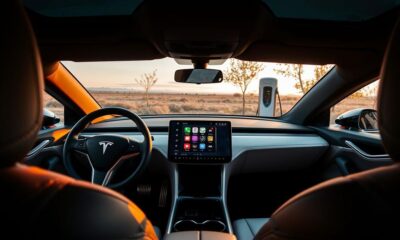
 Tesla Tuning2 months ago
Tesla Tuning2 months agoTesla CarPlay: Does Tesla Have Apple Integration?
-
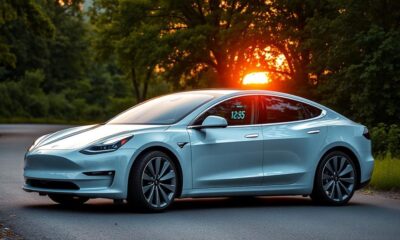
 Tesla Tuning2 months ago
Tesla Tuning2 months agoTesla Mileage: How Many Miles Can You Drive on a Full Charge?
-

 Tesla Tuning2 months ago
Tesla Tuning2 months agoHow Much Does It Cost to Lease a Tesla? Get the Full Breakdown!
-
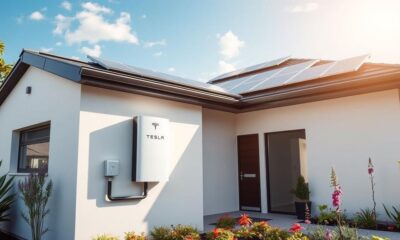
 Tesla Tuning3 months ago
Tesla Tuning3 months agoTesla Powerwall Cost Breakdown: How Much Will It Save You?



























